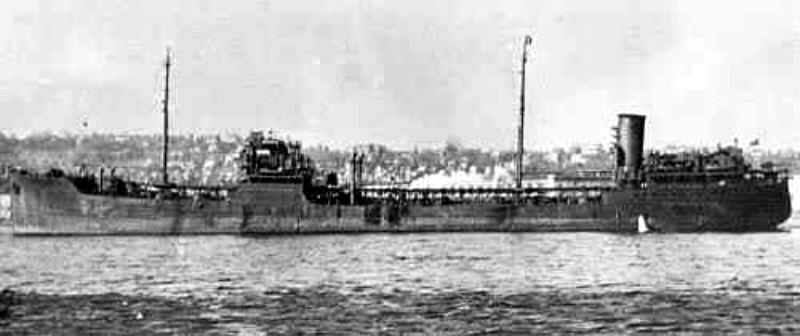
Roland Hampshire was born in Ossett on the 1st May 1916, the son of Arthur Hampshire and Mary Heald, who married at South Ossett Christ Church on the 13th November 1915. Arthur, a bachelor, was working as a mill hand aged 26 years and Martha Ann, a 20 year spinster. Both gave their address as 1, Teall Street, Ossett. By 1939 the couple had moved to live at Street Lane, Morley.
Roland Hampshire joined the Royal Navy and served during WW2 aboard the 6,768 ton steam tanker S.S. Coimbra. In January 1942, the S.S, Coimbra was bound for the U.K. from New York and was carrying 9,000 tons of lubricating oil. At 09.41 hours on the 15th Jan 1942, the unescorted Coimbra (Master John Patrick Barnard) was hit by one G7e torpedo from the German U-Boat U-123, commanded by Lieutenant Reinhard Hardegen, which had spotted the lights of the tanker astern while the U-boat was proceeding eastbound following the southern shore of Long Island, USA.

Above: The S.S. Coimbra, built by Howaldtswerke AG, Kiel, Germany in 1937 and owned by Socony Vacuum Transportation Co Ltd, Montreal, Canada. Sunk by U-123 on the 15th January 1942, off the coast of Long Island, New York.
The torpedo struck on the starboard side just aft of the superstructure. A huge towering explosion lit up the night sky and the cargo of oil quickly caught fire and spread across the water. Residents from the Hamptons on Long Island could see the fire at sea 27 miles away and alerted the authorities. At 09.59 hours, the coup de grâce hit the tanker underneath the funnel and her stern settled fast, striking the sea floor after five minutes. Like his previous victim, the Norness, the bow of the Coimbra was sticking out of the water. Hardegen commented: “These are some pretty buoys we are leaving for the Yankees in the harbor approaches as replacement for the lightships”.
The tanker later sank completely. Of the entire crew of 46 men, including four Navy and two Army gunners, there are only 9 survivors left to tell of the sinking. The master, 29 crew members and six gunners were lost.1 Nine survivors, six of them wounded were rescued from the rough seas. Two crew members were picked up by USS Rowan (DD 405) and landed at Argentia, Newfoundland. The remaining survivors were rescued by another American destroyer and landed at St. Johns, Newfoundland.
The U-123 was taken out of service at Lorient, France on the 17 June 1944 and scuttled there on the 19th August 1944. Surrendered to France in 1945, the U-123 became the French submarine “Blaison”. The “Blaison” was finally decommissioned on the 18th August 1959 as Q165. Korvettenkapitän Reinhard Hardegen is one of the last surviving German U-boat commanders. He sank 22 ships, amounting to 115,656 gross register tons sunk, making him the 24th most successful commander in World War II. He was still alive in 2017 aged 104 years.
Able Seaman Roland Hampshire, aged 25 years, son of Arthur and Martha Ann Hampshire, of Gildersome, Leeds, died at sea, aboard the S.S. Coimbra (HMS President III) on the 14th January 1942. He is remembered at the Chatham Naval Memorial Panel 54, 2.2
After the First World War, an appropriate way had to be found of commemorating those members of the Royal Navy who had no known grave, the majority of deaths having occurred at sea where no permanent memorial could be provided. An Admiralty committee recommended that the three manning ports in Great Britain – Chatham, Plymouth and Portsmouth – should each have an identical memorial of unmistakable naval form, an obelisk, which would serve as a leading mark for shipping. The memorial was unveiled by The Prince of Wales, the future Edward VIII, on 26 April 1924. After the Second World War it was decided that the naval memorials should be extended to provide space for commemorating the naval dead without graves of that war.
References: